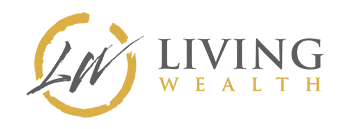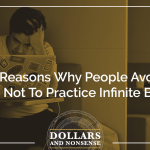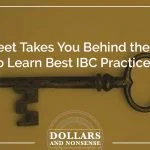In this episode, we explain the difference between direct recognition and non-direct recognition policy loans and how they impact your policy as you practice infinite banking.
There are many misconceptions out there in the debate over direct versus non-direct recognition. We’re here to share the truth to help you make a better decision regarding your infinite banking policy.
A quick forewarning to all listeners: this isn’t a good starter episode if you are relatively new to this podcast or infinite banking. We’d suggest starting with one of the more general episodes. We’re going to tackle a particular subject that is deep in the weeds.
Revenue Recognition Topics Discussed:
- What is direct recognition and non-direct recognition policy loans
- Mutual life insurance
- The big myths and why they’re dead wrong
- What Nelson Nate really thought about the two options
- Is one better than the other
- Which one is right when
- Which one is right when in a strategy of stacked policies
- What actually matters when determining whether or not a policy is right for you
Episode Resources:
- Gain access to our Secret Banking Masterclass now FREE to listeners of the podcast here now
- What is Infinite Banking
- Credit: Episode art background Photo by Jon Tyson
Podcast transcript for episode 102: Revenue Recognition With Infinite Banking
Nate: In this episode, we explain the difference between direct recognition and non-direct recognition policy loans, and how they impact your policy as you practice infinite banking. There are many misconceptions out there in the debate over direct versus non-direct. And we’re here to shine the light of truth on the subject to help you make a better decision when it comes to your infinite banking policy. She’s Holly and she helps people find financial freedom.
Holly: He’s Nate. He makes sense out of money. This is Dollars and Nonsense. If you follow the herd, you will be slaughtered.
Nate: All right. Well, a quick forewarning to all of you listeners out there. If you are relatively new to this podcast, or you are relatively new to the world of infinite banking, might I suggest pausing this episode real quick, going backwards in the podcast, finding other topics to get to, especially in the world of infinite banking first, then come back to this because what we’re going to tackle today is a very specific subject that most of the time, you only hear debated around on Google searches about infinite banking and so forth.
So we just, Holly and I had gotten questions about this issue many times by clients. And so we really want to share our perspective on what we’ve really feel like is the truth to this conversation. And that conversation is direct recognition versus non-direct recognition. So we can start off just by describing what we’re even talking about, Holly. So what is the simplest definition for direct recognition and non- direct recognition? What are we even talking about here?
Holly: The simplicity is that really with direct recognition, you get dividends on your money borrowed out, that that dividends scale is consistent if you want to say it the most paid out. So even if you borrow money, you have a dividend that is being paid on a dividend scale. That’s the simplest way of saying it in my viewpoint. Non-direct actually can change the dividend scale on money being borrowed out, but it can go up or down depending on how the company’s doing and depending on the dividends. So they will have a set dividend scale on money being borrowed out. But it doesn’t mean that it’s always lower. It can be higher. So I think that the misconception is that there’s no dividends, Nate, being paid out, instead of understanding that the dividend is adjusted with direct recognition.
Nate: Yeah, I think so. I think that’s exactly right. Essentially, just to wrap that up, a non-direct recognition policy pays out a dividend to all their policy holders, and it’s going to be the same, regardless if there’s loans or not. So in a non-direct recognition policy, there’s no change to your dividend if you borrow, or if you don’t. And in direct recognition policy, there probably will be a change on your dividend, on the borrowed money of the policy. The dividend may go up when you borrow, it may go down when you borrow, and we’re going to talk in detail about what causes that.
But just so we’re all on the same page, what we’re talking to is on these mutual life insurance companies that are paying out dividends. Some use non-direct recognition, which really means that they don’t recognize if you have a policy loan or not. They just pay, a set, the same dividend they would have anyway, versus direct recognition. They do recognize if you have a loan and they may change the dividend on the borrowed money, either increase your dividend when you borrow or decrease your dividend when you borrow. So there’s more on that in a minute, but Holly, the biggest misconception out there-
Holly: Biggest myth.
Nate: … the biggest myth is that for some reason, there’s people out there on Google and YouTube and so forth that are telling you that you can’t use a direct recognition company to do infinite bank as if that was the only factor to determine whether or not a policy works is if they recognize if they change your dividend when you borrow money or if they don’t. And the reason why it’s so crazy to me, that people are saying that is because Nelson Nash, the creator of the concept of infinite banking, the guy who wrote the book on it that started everything, in all of his examples, he used a direct recognition policy.
And so all these, there’s people online who were saying you can’t use direct recognition or you shouldn’t use direct recognition to practice the infinite banking concept. And essentially saying, I guess, Nelson Nash wasn’t doing infinite banking when he created infinite banking. I just don’t get it. So anyway, we’re here to dispel that myth I think, shine some light on what’s actually happening in policies. And really, if you don’t get anything out of this episode and you have to stop right now, what we’re trying to say is it does not matter if your policy is direct recognition or if it’s non-direct recognition. It doesn’t. Anyone who tells you that it does matter is not telling the truth. That’s just one element of the policy.
Sure. We should talk about it. But just because a company’s direct recognition does not mean you shouldn’t use their policies or that they won’t work. There’s so many myths around it. There’s so many misconceptions around it. And we’re here to kind of stamp that out because it’s a little bit ridiculous that there’s people out there saying that it doesn’t work when Nelson Nash in his book used one, it just doesn’t matter. The policy is going to be good or not, regardless if there’s a direct recognition loan or a non-direct recognition loan.
So we’re going to dive into that, Holly. The biggest myths so far is that it won’t work. We do think it does. I would also like just to mention that Holly and I, and I know you do too, I own nine policies. I own nine policy, nine banking policies. I got them over eight years. Five of those policies are with a direct recognition companies, two of them actually, two different companies for those five policies and the other four policies are with non-direct recognition companies. And guess what? I’ve used them all. And guess what? They’ve all made me money. They all look really great. If it was bad for me to have them, I think I would have experienced it.
And so Holly, you and I, we try to figure out what’s best for our clients. Absolutely. You can let the nickel hide the dime if you’re going to say, I know this policy looks so good, it’s an amazing, the best policy I’ve ever seen. But it’s direct recognitions and I heard online that I shouldn’t do one of those. So I don’t think I can accept that. That’s kind of, that’s a foolish move
Holly: Or Nate, you hear, well, my agent, another agent told me that this, because it’s direct recognition, I don’t get paid any dividends on my loan if I have a loan now.
Nate: Exactly.
Holly: And true, literally I’ve heard that from clients even within the last week. Well, I don’t get any money on dividends. That’s what I was told. And I do laugh when I hear that. I’m like, so not true because if it was true, the infinite banking concept would not work with direct recognition. And therefore the founder of the infinite banking concept, Nelson, wouldn’t have been able to implement such an amazing system with direct recognition policies. It really irks me, I guess when I have somebody says that to them, because either the agent doesn’t understand non-direct and direct recognition, or they’re just only working on direct recognition.
Nate: I think they understand it. I do. Yeah. I think they understand it. I think that they have just built relationships with one or two companies that they like who happened to be non-direct and they’re trying to, they’re using as a marketing ploy. That’s all they’re doing. They’re saying, yeah, if you use it, you’re crazy. Come over to me. I only use non-direct, aha ha, as if that’s better. And then they’ll say, to practice infinite banking, you’ve got to use non-direct recognitions. It’s just funny to me, the guy who wrote the book on infinite banking use direct recognition policies. So maybe actually we shouldn’t be using non-direct if we can argue that we’re doing, because we we’re not doing what Nelson did.
Holly: We’re not doing what Nelson did. Exactly. I mean, if he’s only using direct recognition examples, and maybe it’s the non-direct, I mean, you could go on the other side-
Nate: I know, it’s crazy.
Holly: … he doesn’t promote non-direct so maybe it’s false. And I think even sometimes with those agents, I don’t even know if they realize that the examples Nelson is using are direct recognition. So it’s counter- intuitive to what you’re saying if you want somebody to start an IBC policy and really understand the infinite banking concept to say, you can only use non-direct.
You heard Nate say he’s actually got more direct versus non-direct and yet he’s still making money. I’m going to go a step further and say, Nate, some of my direct recognition policies are actually better and performing better than some of my non-direct policies with loans because of the dividend scale that takes place.
Nate: Exactly. Me too.
Holly: So I cannot in all good conscience, say one is better than the other.
Nate: No.
Holly: That it really depends on which company you’re using and what works best for the client. And that’s why you really have to have an agent who understands what they’re trying to design and do for you in order for you to be able to implement it. But to say this company is better because it’s non-direct versus this company that direct is just a myth. It’s a falsehood. And you can’t really look at that. You actually have to look how companies are performing, the ancient companies.
Nate: Look at the policies. Yeah. You got to look at them. You got to look at the-
Holly: And the policies, just what they’re providing,
Nate: Especially, we talked about that too. We do write with, we have, I think four, I work with four non-direct recognition companies and one direct recognition. We’re not making this argument because we just want to tell you to use direct recognition. We’re just simply saying the mantra that’s out there is incorrect. We still do a lot of non-direct recognition policies. It’s probably still the majority, but we can’t just avoid direct recognition if the policy is really good, just because it’s direct recognition. And in fact it might even be better. That’s what we talk about.
So here’s what it is, Holly, let me explain it. Here’s what direct recognitions really means. I’m crafting this as carefully as I can. So remember a non-direct recognition policy when you take a loan out, it doesn’t make any changes to your dividends. T he dividends stays the same. In a direct recognition policy here’s what happens. The insurance company, if they’re direct recognition, they have two dividend scales. They have one dividend scale, which is just their overall scale, their normal dividend payout for that year that they announced. There’s this one, it’s the overall dividend scale. They have a second dividend scale that is the dividend scale for the borrowed money, for all the policies that taking that policy loans and how much is borrowed.
So your policy can receive two different dividend scales. One scale is all the money that’s not borrowed. And one scale is for all the money that is borrowed out of that one policy. So some people, Holly, there’s a myth out there that says direct recognition companies reduce your dividends if you borrow. That is not a true statement. What they do is they set the dividend on your borrowed money to guarantee dividend rate. Typically, the borrowed money dividend rate that you’re receiving is based on really your loan rate. A lot of times, these direct recognition companies will have it. Like if the loan rate for a policy loan is 5%, then the dividend rate on the borrowed money is 5% or maybe it’s like 4.5%, half percent below it or something like that. It’s right next to the loan rate on a policy loan. That’s what it’s set at. Okay.
It has nothing to do with whether it’s reducing or not. The question is, when I take a loan out, will it reduce my dividend? The question is whether or not the overall rate, dividend rate is higher than let’s say 5% or lower than 5%. As we said at the very beginning, direct recognition simply just means that they recognize you have a policy loan and that loan gets its own, the cashflow that’s borrowed out on loan will receive a dividend based on a set dividend rate. That does not mean they’re reducing your dividend. That just means it’s receiving is the rate. It might reduce your dividend compared to the other dividend scale on the normal money.
It might also increase your dividend in any given year. There’s two companies who are notorious for that right now. I’m not going to start naming names. Really. I thought I would. I’m just not. But I mean, there are companies right now with direct recognition that if you borrow from your policy, you will get a higher dividend check that year. So I mean, direct recognition is not saying we’re going to lower your dividend if you borrow money. No. There’s a set dividend scale on the borrowed money. It’s tied to whatever the loan rate is at the time. That’s normally what they do. And it might be higher. It might be lower than their just normal dividend rate. Whereas a non-direct everyone gets the same thing. It exists, the director recognitions idea exists. The companies will tell you different things, but it mainly exists if the company has a guaranteed loan rate, they’re all going to be direct recognition. They tried to make it as fair as they could.
Announcer: Are you still stuck in insecurity and uncertainty? Do you want to feel like a financial genius and confident about your future? Holly and Nate have prepared something exclusively for Dollars and Nonsense listeners. It’s called The Secret Banking Masterclass. You can gain free access to this course by visiting livingwealth.com/secretbanking. That’s secret banking, all one word. The course will share with you how the conventional system stacks the deck against you, and exactly how to break free from their system. We believe in challenging the status quo. We believe in defying conventional wealth tools while maintaining traditional values. After all, most of those conventional tools only ever seem to make someone else on the inner circle rich. Visit livingwealth.com/secretbanking. That’s secret banking, all one word. Ease your worry, and start your journey towards security today. Visit livingwealth.com/secretbanking. Now, back to the great episode with Nate and Holly.
Holly: And so I think, Nate, you say it beautifully in explaining it, but it’s just a direct recognition as two dividend scales, one for borrowed money, one for not borrowed money. A non-direct has the same dividend scale, whether it’s borrowed money or not. Okay? That just means [inaudible 00:15:08]
Nate: Exactly. Does that make one better or one worse? No, it doesn’t. It really doesn’t because as I said, there’s some companies whose normal dividend skills are lower than the borrowed scale. So you borrow money, you get a higher dividend. Other companies, the dividend scale normally is higher than the borrowed scale so you get a lower, but either way, a such a small change overall, in reality, it’s such a minor impact on the policy overall that that one factor alone cannot determine whether or not it’s a good policy or not. We have to take it into a consideration potentially, but the question really is, Hey, if I borrow money, does this policy still look good?
And if the answer is yes, by the way, let me just say this. If you have a direct recognition policy and the policy looks good, even when you’re borrowing money, which they all do, then some could even make the argument that’s it’s better to do infinite banking. It’s safer to do infinite banking there because you’re guaranteed to get a dividend anytime you borrow money. That’s not the case in a non-direct. They can just lower the dividend scale anytime they want. And you can have loans out and you just receive a lower dividends, you’re still paying the interest rate on it, and you don’t have that background. So you could almost make an argument that it’s safer and potentially better to have a direct recognition policy, you easily could.
So there’s all these myths out here that you got to use non-direct. I’m just simply telling you, Nate Scott is not only using non-direct. Nate Scott is using direct as well. In fact, more so than non-direct and it’s working really well. The same thing goes with Nelson Nash, the creator of the concept. So maybe we should get off the high horse there and say, if a policy is good, it’s good. Stop letting the nickel hide the dime, get yourself a good policy with a good mutual company that’s paid dividends every year for over 100 years. It’s highly rated and is ready to rock and roll with strong cash value. I think you’re going to be okay on this one.
Holly: And I think, Nate, I just want to reiterate, a direct recognition company does not stop paying you dividends if you borrow money. The myth it’s going to reduce your dividends, it doesn’t pay you dividends on the borrowed money. Not true. Okay?
Nate: It’s just false. Yeah. People say those words to try to get you, to convince you that their policies are going to be better than somebody else’s for some reason. Crazy. Holly, I’ll also mention this, by the way, I’m not trying to convince you to buy from a direct recognition company. I don’t care. We work with all of them, but I am trying to convince you that it should not matter to you. But if it does matter to you, then just say so. It’s that simple. Don’t overthink this guys.
Holly: Our goal is not to say you only buy direct recognition or you only buy non-direct recognition. The goal really was to, because we’re getting so many questions and there’s so much out there that it can’t work with direct recognition just to acknowledge the fact of what that difference really is for you. And if you only want to work with a non-direct, then say that. But if you want to look at both, you can look at both. Typically, when we design and work with a client in a policy, what we’re really trying to do is design the best policy for that client and what works the best with them, with what we have at that point in time with the insurance companies.
Like Nate, he has more direct. I have more non-direct, but it’s not because of one’s better than the other. It just happens to be on when I bought policies at the time. But when I look forward, I used to think it mattered just like Nate, until I really understood what it was about, direct versus non-direct and really understood Nelson’s book. And then he is using direct recognition. Now it doesn’t really matter to me, Nate. I don’t even look at if it’s a direct or non-direct as much as I look at how is this going to be the best for my family and how is this policy design going to work. And that really comes into where I want to buy and how the company is currently doing.
Nate: We can’t afford to let this one small element of an overall policy determine whether it’s a good policy or not. Because the honest truth is there’s three main direct recognition companies out there that people are buying from and end up making space and all three have really good policies. There’s really good policies. Why would you just throw the baby out with the bath water and not buy the policies? Just they’re really good. And that’s not to say that non-direct recognition companies are not as good or anything like that. We’re not. Get over yourself. Just, the whole reason this podcast was created was not to open a new can of worms. It was really just to close it. There’s misconceptions out there. People hear online, they shouldn’t use it. They get afraid or something like that about getting a direct recognition as if it really mattered. It doesn’t.
There’s a lot of agents out there who don’t believe that it matters too. It’s not just Nate and Holly. And the main ones who tried to tell you that you have to use non-direct. This is the truth. I don’t think they actually believe that. If they do, God bless them. But what they’re really saying is we happen to work with non-direct recognition companies so we want to try to convince you that they’re better. One agent, I hope he doesn’t listen to podcasts, but I mean, they’re all about saying, we got to do non-direct, got to do non-direct. And they’re always trying to mention things about Nelson Nash in their podcasts, in they’re dealings. So I was saying, we’ve got to do what Nelson did. Get over yourself. Stop doing all this other stuff. Just focus on Nelson’s book, do what he did, do what he did.
I’m thinking, but yet you’re telling everyone that if they bought from direct recognition. I wouldn’t say they’re that serious about it, but I’m just somebody it’s annoying me when people talk like that, because Nelson Nash used direct recognitions in his book. People have using direct recognitions policies for years, including me. The only difference is that there’s two dividend scales at the company. One is for borrowed money, one is for not borrowed money as opposed to just one overall dividend scale. And that one little difference does not determine if a policy looks good or not. It just doesn’t, people.
Holly: And that our goal really like Nate said, we just want to dispel that myth. That one is better than the other. I really would argue that one’s not better than the other. It’s what you want to do, but you need to understand that it is the company and the policy design and what you’re using it for that is essential. Not the direct or non-direct.
Nate: Yeah, I agree. And just to simply say, this is what I actually promote. I suggest that people own some of each. That’s my suggestion, because there are going to be times when using your direct recognition policies are going to be better for you. You might actually end up getting into a time where you’d get a higher dividend for using those. There also may be times when using the non-direct recognition policies first will be better for you.
So that’s really what I do in my own life. Just trying to be transparent here. I will choose to borrow from a non-direct or direct, I mean, depending on which one has money and so forth, but I mean, assuming I have money in both sides, I’ll choose which one to use based on what makes the most sense at that time. But that doesn’t mean it’s always going to make more sense to use the non-direct or always make more sense to use the direct. Just be flexible with it. Get yourself some good policies. Don’t overthink it too much. Don’t let the nickel hide the dime and we’ll go from there. Anything else, Holly, you’d like to add to it?
Holly: No. I think we’ve summed it up pretty good.
Nate: I’m sure you have a lot more questions on it. We’re here to help. We’re here to help. We’re on your side. So let us know, but this has been another episode of Dollars and Nonsense. If you follow the herd, you will get slaughtered.
Holly: For free transcripts and resources, please visit livingwealth.com/e102.
Announcer: Dollars and Nonsense podcast listeners, one more thing before you go. Ease your worry and start your journey towards security today. Visit livingwealth.com/secretbanking. You’ll gain instant free access to the special one hour course Holly and Nate made for you. Again, that’s livingwealth.com/secretbanking.









